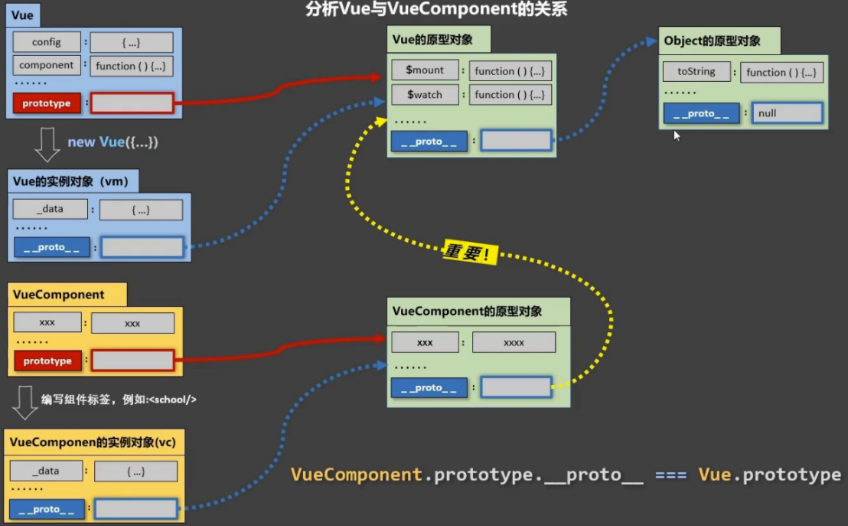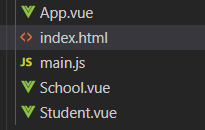Vue组件
Vue组件
组件定义:
组件:实现应用中 局部 功能 代码 和 资源 的 集合
组件化:当应用中的功能都是多组件的方式来编写的, 那这个应用就是一个组件化的应用
注:
模块:向外提供特定功能的 js 程序, 一般就是一个 js 文件
模块化:当应用中的 js 都以模块来编写的, 那这个应用就是一个模块化的应用。
1.1、非单文件组件
非单文件组件:一个文件中包含 n 个组件
组件创建的三步骤:
① 定义组件(创建组件)
② 注册组件
③ 使用组件(写组件标签)
一、定义组件:
使用 Vue.extend({配置对象}) 创建,
其中 配置对象 和 new Vue(options) 时传入的那个 options 几乎一样
区别如下:
el 不要写
data 必须写成 函数,以 return 形式返回对象
注:使用template可以配置组件结构。
二、注册组件
局部注册:靠 new Vue 的时候传入components 选项
全局注册:靠 Vue.component('组件名',组件)
三、编写组件标签:直接写 Vue.extend() 对应对象的标签
<div id="root">
<hello></hello>
<hr>
<h1>{{msg}}</h1>
<hr>
<!-- 第三步:编写组件标签 -->
<school></school>
<hr>
<!-- 第三步:编写组件标签 -->
<student></student>
</div>
<div id="root2">
<hello></hello>
</div>
<script type="text/javascript">
//第一步:创建school组件
const school = Vue.extend({
template:`
<div class="demo">
<h2>学校名称:{{schoolName}}</h2>
<h2>学校地址:{{address}}</h2>
<button @click="showName">点我提示学校名</button>
</div>
`,
data(){
return {
schoolName:'Hello',
address:'shanghai'
}
},
methods: {
showName(){
alert(this.schoolName)
}
},
})
//第一步:创建student组件
const student = Vue.extend({
template:`
<div>
<h2>学生姓名:{{studentName}}</h2>
<h2>学生年龄:{{age}}</h2>
</div>
`,
data(){
return {
studentName:'张三',
age:18
}
}
})
//第一步:创建hello组件
const hello = Vue.extend({
template:`
<div>
<h2>你好啊!{{name}}</h2>
</div>
`,
data(){
return {
name:'Tom'
}
}
})
//第二步:全局注册组件
Vue.component('hello',hello)
//创建vm
new Vue({
el:'#root',
data:{
msg:'你好啊!'
},
//第二步:注册组件(局部注册)
components:{
school, //简写形式(school: school)
student
}
})
new Vue({
el:'#root2',
})
</script>
注意点:
1.关于组件名:
① 一个单词组成:
第一种写法(首字母小写):school
第二种写法(首字母大写):School
② 多个单词组成:
第一种写法(kebab-case命名):my-school
第二种写法(CamelCase命名):MySchool (需要Vue脚手架支持)
备注:
1.组件名尽可能回避HTML中已有的元素名称
2.可以使用name配置项指定组件在开发者工具中呈现的名字。
2.关于组件标签:
第一种写法:
第二种写法:
注:不用使用脚手架时,会导致后续组件不能渲染。
3.一个简写方式:
const school = Vue.extend(options) 可简写为:const school = options
1.2、组件嵌套
<body>
<div id="root">
<school></school>
</div>
</body>
<script>
const stu = Vue.extend({
name: 'stu',
template: `
<div>{{name}}</div>
`,
data(){
return {
name:'T4mako'
}
}
})
const school = Vue.extend({
// 将嵌套组件用 名字 引入
// 必须放在 父盒子 中 表示子组件
template: `
<div>
AAA
<stu></stu>
</div>
`,
components: {
stu
}
})
const vm = new Vue({
el: '#root',
// 局部注册组件
components: {
school,
}
})
</script>
1.3、VueComponent
1、school 组件 本质是一个名为 VueComponent 的构造函数,且不是程序员定义的,是 Vue.extend 生成 的。
2、我们只需要 写或,Vue解析时会帮我们创建 schoo l组件的 实例对象,
即Vue帮我们执行的:new VueComponent(options)
3、特别注意:每次 调用 Vue.extend,返回的都是一个 全新的VueComponent (VueComponent 的构造函数 不唯一)
4、关于this指向:
① 组件配置中:
data函数、methods中的函数、watch中的函数、computed中的函数 它们的 this均是【VueComponent 实例 对象】。
② new Vue(options) 配置中:
data函数、methods中的函数、watch中的函数、computed中的函数 它们的 this 均是【Vue实例对象】。
5、VueComponent 的实例对象,以后 简称 vc(也可称之为:组件实例对象)
Vue的实例对象,以后简称 vm。
vm 与 vc 区别:vc 没有 el,data 必须写成 方法
1.4、重要的内置关系 (VC 与 Vue)
1、一个重要的内置关系:VueComponent.prototype.__proto__ === Vue.prototype
2、什么要有这个关系:让 组件实例对象(vc)可以 访问到 Vue 原型上的属性、方法。

Vue.prototype.x = 99
//定义school组件
const school = Vue.extend({
name:'school',
template:`
<div>
<h2>AA</h2>
<button @click="showX">点我输出x</button>
</div>
`,
data(){
return {
}
},
methods: {
showX(){
console.log(this.x) //99
}
},
})
1.5、单文件组件
一个文件中只包含 1 个组件
单文件组件名都是 .vue 结尾的
创建组件到注册使用过程:
结构:
注:
① 创建组件 XXX.vue
② App.vue (引入所有的 vue 组件)
③ 创建 main.js 做为入口文件,引入 app.vue , 创建 vm,使用 template 创建 app
④ 在 index.html 创建 root 容器,引入 vue.js , main.js
School 组件创建:
<template>
<!-- 组件结构 -->
<div class="demo">
<h2>学校名称:{{name}}</h2>
<h2>学校地址:{{address}}</h2>
<button @click="showName">点我提示学校名</button>
</div>
</template>
<script>
// 组件js
// 默认暴露
// 简写方式,可以省略Vue.extend()
export default {
name:'School',
data(){
return {
name:'Hello',
address:'shanghai'
}
},
methods: {
showName(){
alert(this.name)
}
},
}
</script>
<style>
/* 组件样式 */
.demo{
background-color: orange;
}
</style>
创建 App.vue (引入所有的 vue 组件)
<template>
<div>
<School></School>
<Student></Student>
</div>
</template>
<script>
//引入组件
import School from './School.vue'
import Student from './Student.vue'
export default {
name:'App',
components:{
School,
Student
}
}
</script>
创建 main.js 做为入口文件,引入 app.vue , 创建 vm,使用 template 创建 app
注:浏览器不能直接解析 .vue 文件,需要脚手架
// 引入 app.vue
import App from './App.vue' // 注:浏览器不能直接解析 .vue 文件,需要脚手架
// main.js (入口文件)
// 专门用于创建 Vue 对象 vm
new Vue({
el:'#root',
template:`<App></App>`,
components: {App},
})
创建 index.html 文件:
<!DOCTYPE html>
<html>
<head>
<meta charset="UTF-8" />
<title>练习一下单文件组件的语法</title>
</head>
<body>
<!-- 准备一个容器 -->
<div id="root"></div>
<script type="text/javascript" src="../js/vue.js"></script>
<script type="text/javascript" src="./main.js"></script>
</body>
</html>